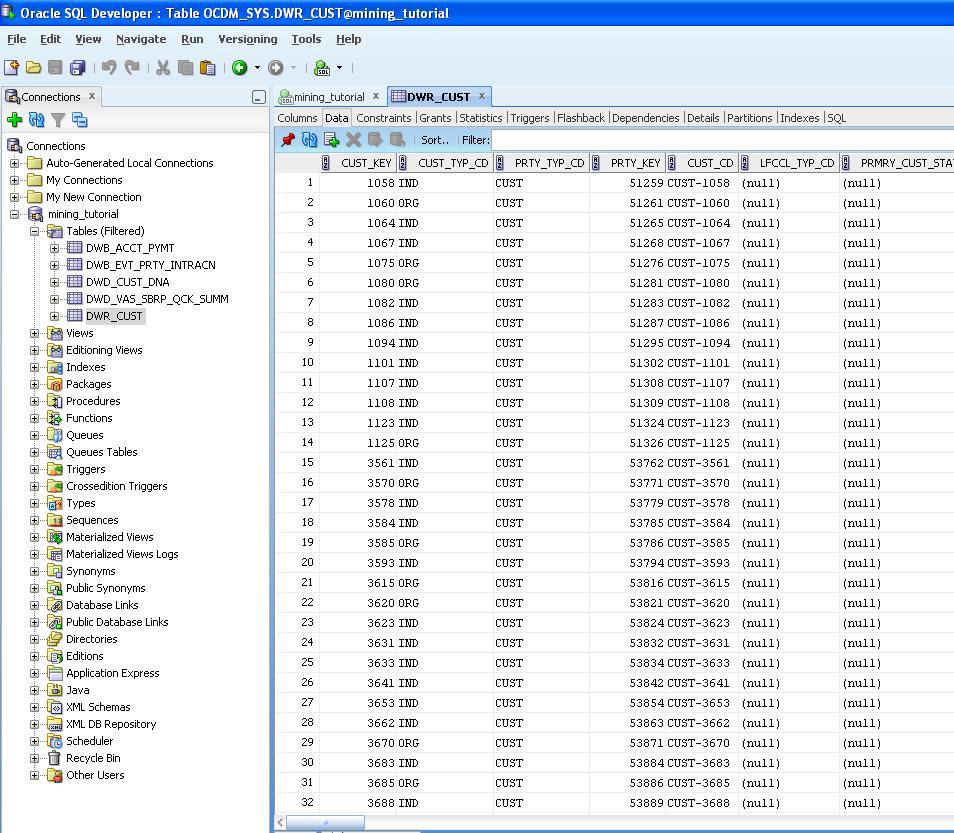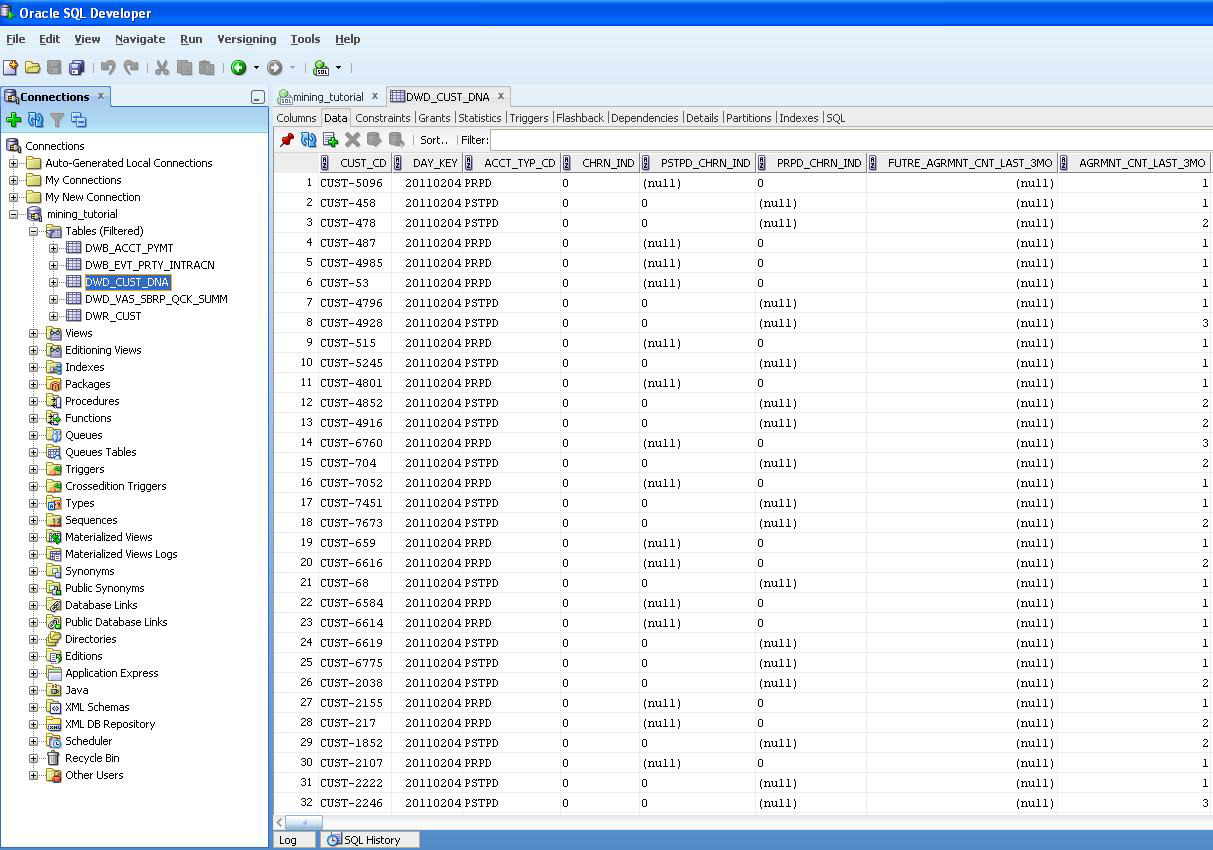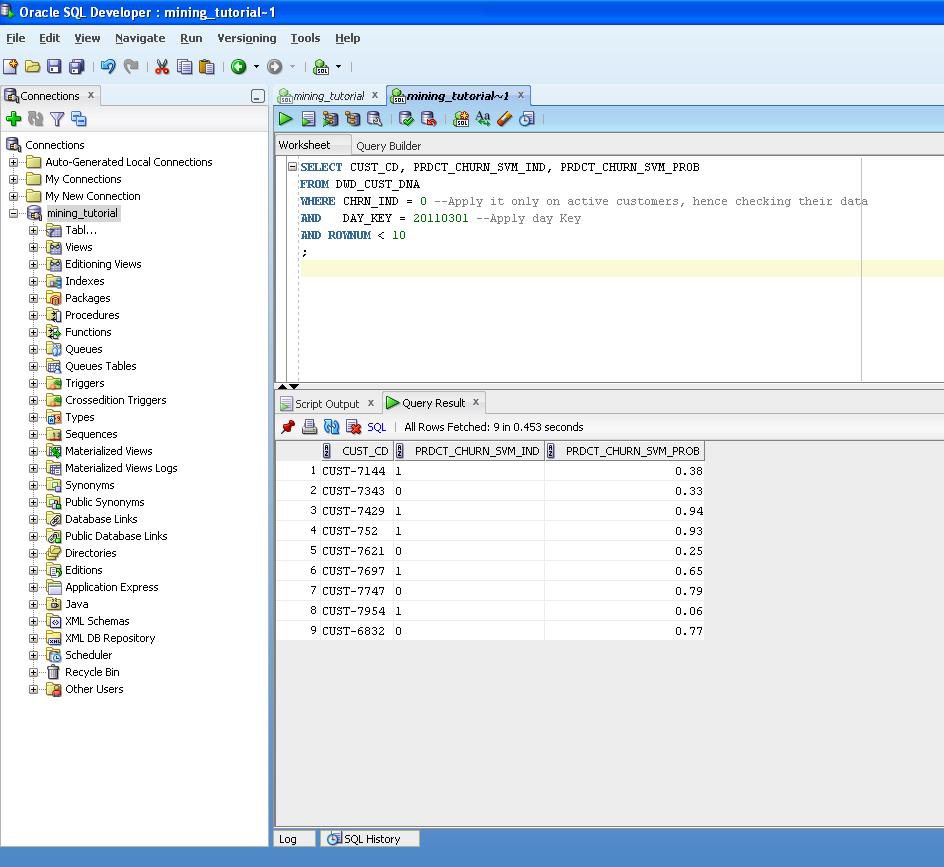Derived Tables in Oracle Communications Data Model
Derived tables have a DWD_ prefix.
Derived tables are tables where one of the following apply:
-
Have as values the result of a non-aggregate calculation against the data in the foundation layer tables.
-
Have some minimal level of aggregation, typically at the day level (for example,
DWD_CNT_DAY). -
Summarize, at day or month level, all activities over the period of specific processes, split in various attributes (for example,
DWD_ACCT_BAL_MO).
Some derived tables leverage, and hence are dependent on, other derived tables (for example DWD_CUST_MNNG).
Depending on the type of derived table, you customize the table as follows:
-
Tables that hold the results of a calculation such as the
DWD_BER_FER_ERR_RATIO_DAYtable that contains values that are the daily BER (Bit Error Rate) and FER (Frame Error Rate) statistics about the network elements. -
Result tables for the data mining models (for example,
DWD_CUST_MNNG).
- Creating New Derived Tables for Calculated Data
If, during fit-gap analysis, you identified a need for calculated data that is not provided by the default derived tables, you can meet this need by defining new tables or, alternatively, by adding missing dimensions and measures to existing derived tables. - Customizing Oracle Communications Data Model Data Mining Models
See Also:
The Derived Tables topic in Oracle Communications Data Model Reference for a list of all of the derived tables in the default Oracle Communications Data Model
For a list of only those derived tables that are results tables for the data mining models, see the chapter on Data Mining Models in Oracle Communications Data Model Reference
Creating New Derived Tables for Calculated Data
If, during fit-gap analysis, you identified a need for calculated data that is not provided by the default derived tables, you can meet this need by defining new tables or, alternatively, by adding missing dimensions and measures to existing derived tables.
When designing these tables, name the tables following the convention of using the CWD_ prefix (for Customized Warehouse Derived) or DWD_ (for Data Warehouse Derived). Make sure all the main dimensions are put first and have Foreign Keys to their corresponding reference or lookup tables. Attributes that add information only, avoiding costly joins, should not be part of the Primary Key of the derived table. Some dimensions that are part of a hierarchy do not necessarily need to be part of the Primary Key. All measures should be put afterward, grouped if possible by similar meaning. Make sure that all monetary measures should have the LOCAL and REPORTING amount associated, and if possible the currency (as required in the TM Forum SID).
See Also:
Oracle Communications Data Model Reference for details on dimensions that are part of a hierarchy
Customizing Oracle Communications Data Model Data Mining Models
Some derived (DWD_) tables in the default ocdm_sys schema are the results of data mining models defined in the default Oracle Communications Data Model. Those models are defined in the default ocdm_sys schema that also comes with Oracle Communications Data Model.
Oracle Communications Data Model data mining models get source data from views defined on two derived tables (DWD_) and a base table (DWB_). These tables are:
-
DWD_CUST_DNA -
DWD_VAS_SBRP_QCK_SUMM -
DWB_EVT_PRTY_INTRACN
Derived tables store data mining models prediction results and model rules, in (DWD_), and use reference tables (DWR_), and look up tables (DWL_). These tables are:
-
DWD_CUST_PROD_AFFLTN -
DWD_CUST_DNA -
DWR_CUST_DT_NODE -
DWD_CHRN_SVM_FACTOR -
DWD_CHRN_SVM_ROC -
DWD_PROMO_SVM_FACTOR -
DWD_PROMO_SVM_ROC -
DWR_CUST_SGMNT -
DWR_CUST_SGMNT_DTL -
DWL_MNNG_LTV_BAND -
DWL_MNNG_LT_SRVVL_BAND
When Oracle Communications Data Model is installed the installer copies the mining source scripts to $ORACLE_HOME/ocdm/pdm/mining/src.
The following table lists the mining scripts:
Table 3-1 Oracle Communications Data Model Mining Scripts
| Script Name | Description |
|---|---|
|
|
Predefined dictionary for customer comment scoring. |
|
|
Initializes mining environment and executes the other three mining scripts. |
|
|
Defines views, which have training/apply data, on source tables. |
|
|
Core mining package that has a procedure for each model. Each procedure drops, creates mining model and scores mining model. |
When you create a customized Oracle Communications Data Model warehouse, you can customize the data mining models in the following ways:
- Creating a New Data Mining Model for Oracle Communications Data Model
Describes the steps to create a data mining model. - Modifying Oracle Communications Data Model Data Mining Models
Describes the steps to customize Oracle Communications Data Model mining models. - How to Customize the Churn Prediction Model
Creating a New Data Mining Model for Oracle Communications Data Model
Describes the steps to create a data mining model.
DWD_ prefix for new results tables.- Define the problem and identify input attributes. Also identify target attribute if the mining problem is supervised.
- Check if the existing mining source views defined in
pkg_mining_etl.sqlscript support the requirement of your problem. Modify the definition of views to support your requirement. Do not remove any columns from view definition unless you are sure that those columns do not make any sense. - If the existing mining source views do not support required fields, create a new table or view to support your requirements. Add the new table to
pkg_mining_etl.sqlPL/SQL package. Modify the intra-ETL programs to support your mining problem requirements. - For each mining problem that Oracle Data Mining supports, there is more than one algorithm. Create a setting table for your mining problem and follow the naming convention. The prefix for a setting table is "
DM_". Add the definition of new setting table toocdm_mining_init.sqlscript. - Add a procedure for your mining problem to the
pkg_ocdm_miningPL/SQL package. This procedure creates the mining model and scores the trained mining model on the apply data. Compile the package. To create the mining model for your problem, invoke the newly added procedure. Make sure your new procedure works according to your expectations. Checkuser_mining_modelsdata dictionary view for trained model. There are more data dictionary views that give information on the trained models.
Related Topics
Modifying Oracle Communications Data Model Data Mining Models
Describes the steps to customize Oracle Communications Data Model mining models.
-
Change the definition of source views used as input to the mining model.
-
If required, change the definition of source derived table,
DWD_CUST_DNA. Do not remove any existing columns. Only add new columns withNULLenable. -
Modify the intra-ETL package of
DWD_CUST_DNAtable. Execute the intra-ETL package to load data intoDWD_CUST_DNAtable. -
Refresh mining views by executing following statement. You need to pass training day and apply day key:
SQL> exec PKG_MINING_ETL.refresh_mining_views(l_trnng_day_key,l_apply_day_key);
-
Train the model again by calling Oracle Communications Data Model mining package.
-
Ensure that the model reflects the new definition (for example, that a new column has been added).
To add a new column to create_prpd_churn_svm_model, perform the following steps:
How to Customize the Churn Prediction Model
After you have populated Oracle Communications Data Model foundation layer and the derived tables, you can leverage the prebuilt Oracle Communications Data Model mining model for some more advanced analysis and predictions.
This tutorial shows you how to predict the prepaid customers who will terminate the service in next three months (churners) based on the populated Oracle Communications Data Model warehouse. Using prebuilt Oracle Communications Data Model Mining models, you can easily and very quickly see the prediction result of your customers, without having to go through all of the data preparation, training, testing and applying process that you must perform in a traditional from-scratch mining project.
After the initially generated mining model, as time goes by, the customer information and their behavior change. Consequently, you must refresh the previous trained mining models based on the latest customer and usage data. You can follow the process in this tutorial to refresh the mining models to acquire predictions on latest customer information.
This tutorial shows you how to generate the Churn Prediction model through Oracle Communications Data Model Mining APIs. To use different parameters in the training process, or customize the model in more advanced fashion, you can also use Oracle Data Miner to do the same work.
- Tutorial Prerequisites
- Preparing Your Environment
Provides a tutorial for preparing your environment. - Generating the Prepaid Churn Prediction Model
For generating prepaid churn prediction model, refresh the mining views defined on mining source tablesDWD_CUST_DNAandDWD_VAS_SBRP_QCK_SUMM. - Checking the Result
Describes the steps to perform after you refresh, train, and generate the data mining model, to check the results with theDWD_CUST_DNAresults table inocdm_sysschema.
Related Topics
Tutorial Prerequisites
Before starting this tutorial:
Review the Oracle by Example (OBE) tutorial "Using Oracle Data Miner 11g Release 2." To access this tutorial, open the Oracle Learning Library in your browser by following the instructions in Oracle Technology Network; and, then, search for the tutorial by name.
-
Install Oracle Communications Data Model.
-
Populate the base, reference, and lookup tables.
-
Execute the intra-ETL.
Ensure that the following tables contain valid data:
DWB_ACCT_STAT_HIST
DWB_BRDBND_USG_EVT
DWB_FIXED_LN_CALL_EVT
DWB_ISP_USG_EVT
DWB_MMS_EVT
DWB_NP_RQST_HDR
DWB_SMS_EVT
DWB_WRLS_CALL_EVT
DWB_WRLS_CNTNT_DNLDG_EVT
DWD_ACCT_DEBT_MO
DWD_ACCT_PYMT_DAY
DWD_CNTCT_CNTR_DAY
DWD_CUST_DNA
DWD_PRPD_ACCT_STTSTC_DAY
DWL_AGE_BND
DWL_AGE_ON_NET_BND
DWL_DEBT_AGNG_BND
DWR_ACCT
DWR_ADDR_LOC
DWR_AGRMNT
DWR_CUST
DWR_BSNS_MO
DWR_CUST_SCR
DWR_DEMOG_ATRIB
DWR_EXTRNL_OPRTR
DWR_HH
DWR_INDVL_DEMOG_VAL
DWR_PROD_SBRPDWR_JB
DWR_SOC_JB
Note:
If you have not populated the real customer data and you only want to learn the Oracle Communications Data Model mining model, you can use the sample data by taking the following steps:
-
Ensure that during the install you generated the calendar data covering the range of 2011 through 2012. For example, by setting the parameters of starting from
"20070101"for 10 years satisfy this condition. -
Download the sample data (
ocdm_for_mining.dmp.zip):http://download.oracle.com/technetwork/database/options/comm-data-model/ocdm_for_mining.dmp.zipThen unzip the sample data and import that data into your new
ocdm_sysschema using the following command:imp system/<password> file=ocdm_for_mining.dmp fromuser=ocdm_sample touser=ocdm_sys ignore=y log=mining_dump_import.log
Preparing Your Environment
Provides a tutorial for preparing your environment.
This tutorial requires a valid, populated Oracle Communications Data Model warehouse.
Note:
For more information about using SQL Developer, refer to tutorial "Getting Started with Oracle SQL Developer 3.0". To access this tutorial, open the Oracle Learning Library in your browser by following the instructions in Oracle Technology Network; and, then, search for the tutorial by name.
To prepare the environment, perform the following steps:
-
In SQL Developer, connect to the
ocdm_sysschema.Tip:
SQL Developer can be found on any Oracle Database Installation under
$ORACLE_HOME/sqldeveloper. -
After you connect to the
ocdm_sysschema, you can see all the tables in that schema. You can narrow down the list by right clicking the "table" and then applying filters: -
(Optional) As mentioned in the Preparing Your Environment, if you have not populated tables with your data you can try using sample data. After you download the sample data, follow these steps to import the sample data:
-
Connect to sqlplus as sysdba:
sqlplus / as sysdba
-
Execute following commands to generate disable constraint script:
spool disable_constraints.sql SET PAGESIZE 15000 SET LINESIZE 1000 conn ocdm_sys/ocdm_sys SELECT 'ALTER TABLE ' || table_name || ' disable constraint ' || constraint_name || ';' FROM user_constraints WHERE STATUS='ENABLED' AND constraint_type = 'R'; SELECT 'ALTER TABLE ' || table_name || ' disable constraint ' || constraint_name || ';' FROM user_constraints WHERE STATUS='ENABLED' AND constraint_type = 'U'; SELECT 'ALTER TABLE ' || table_name || ' disable constraint ' || constraint_name || ';' FROM user_constraints WHERE STATUS='ENABLED' AND constraint_type = 'C'; SELECT 'ALTER TABLE ' || table_name || ' disable constraint ' || constraint_name || ';' FROM user_constraints WHERE STATUS='ENABLED' AND constraint_type = 'P'; spool off
-
Execute
disable_constraints.sqlscript asocdm_sysuser:sqlplus ocdm_sys/ocdm_sys @disable_constraints.sql
-
Import the sample dump into
ocdm_sysschema by executing the following commands:imp system/<password> file=ocdm_for_mining.dmp fromuser=ocdm_sample touser=ocdm_sys ignore=y log=mining_dump_import.log
-
Execute the following commands to generate enable constraint script:
spool enable_constraints.sql SET PAGESIZE 15000 SET LINESIZE 1000 conn ocdm_sys/ocdm_sys SELECT 'ALTER TABLE ' || table_name || ' enable constraint ' || constraint_name || ';' FROM user_constraints WHERE STATUS='DISABLED' AND constraint_type = 'R'; SELECT 'ALTER TABLE ' || table_name || ' enable constraint ' || constraint_name || ';' FROM user_constraints WHERE STATUS='DISABLED' AND constraint_type = 'U'; SELECT 'ALTER TABLE ' || table_name || ' enable constraint ' || constraint_name || ';' FROM user_constraints WHERE STATUS='DISABLED' AND constraint_type = 'C'; SELECT 'ALTER TABLE ' || table_name || ' enable constraint ' || constraint_name || ';' FROM user_constraints WHERE STATUS='DISABLED' AND constraint_type = 'P'; spool off
-
Execute
enable_constraints.sqlscript asocdm_sysuser:sqlplus ocdm_sys/ocdm_sys @enable_constraints.sql
-
-
Review tables to ensure they contain valid data, either from your own customer data, or from the sample data:
-
Review the
DWD_CUST_DNAtable: -
Select and check each of the following tables to ensure that the table is properly populated:
DWR_CUSTDWB_EVT_PRTY_INTRACNDWB_ACCT_PYMTDWD_CUST_DNADWD_VAS_SBRP_QCK_SUMM
Generating the Prepaid Churn Prediction Model
For generating prepaid churn prediction model, refresh the mining views defined on mining source tables DWD_CUST_DNA and DWD_VAS_SBRP_QCK_SUMM.
Note:
This tutorial does not refresh all models. It only refreshes one prepaid churn prediction model. To refresh all of the default mining models based on latest customer data, follow the instructions in Refreshing the Data in an Oracle Communications Data Model Warehouse.



